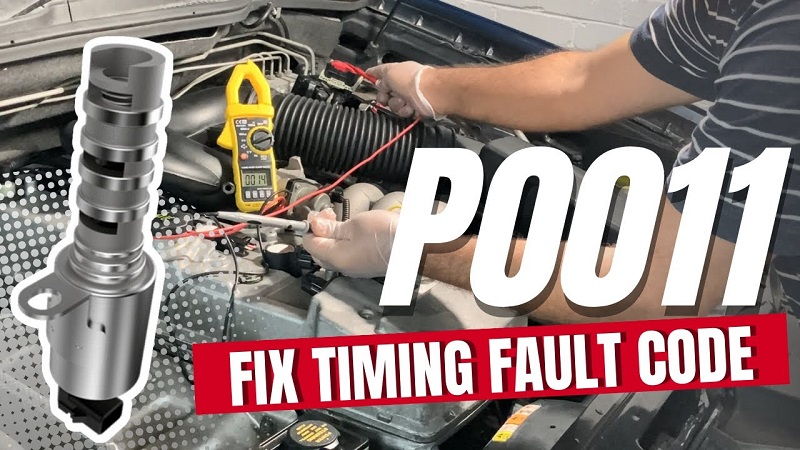This post contains affiliate links. This means I will make a commission at no extra cost to you should you click through and make a purchase [ “As an Amazon Associate, I earn from qualifying purchases.” ]. Read the full disclosure here.
Deciphering the P0011 Code: Understanding “A” Camshaft Position – Timing Over-Advanced or System Performance (Bank 1) GuideMechanic.Com In the realm of automotive diagnostics, error codes like P0011 serve as windows into the inner workings of a vehicle’s engine.
Specifically, the P0011 code refers to the “A” camshaft position – timing over-advanced or system performance issue on Bank 1.
While the code may appear cryptic to the untrained eye, it holds valuable insights into potential issues affecting engine performance.
In this comprehensive article, we delve into the intricacies of the P0011 code, uncovering its significance, causes, diagnostic procedures, and implications for vehicle owners.
See Also: P000F Code: Fuel System Over Pressure Relief Valve Activated
Understanding P0011 Code:

P0011 is a diagnostic trouble code generated by the onboard diagnostics system (OBD-II) when the engine’s computer detects that the “A” camshaft’s position is over-advanced or the system’s performance on Bank 1 is outside of predetermined parameters.
In simpler terms, it indicates that the timing of the camshaft on one side of the engine is too advanced, potentially leading to inefficient combustion and diminished performance.
The Role of Camshaft Timing:
Before delving into the specifics of P0011, it’s crucial to grasp the significance of camshaft timing in the engine’s operation. The camshaft plays a pivotal role in regulating the opening and closing of the intake and exhaust valves, synchronizing these actions with the engine’s pistons’ movement. Precise timing ensures optimal engine performance, fuel efficiency, and emissions control.
Causes of P0011:

Several factors can contribute to the occurrence of the P0011 code, ranging from mechanical issues to sensor malfunctions. Some common causes include:
Timing Chain or Belt Tension:
If the timing chain or belt is loose or worn, it can affect the camshaft’s timing, leading to over-advanced conditions.
Camshaft Position Actuator Malfunction:
The camshaft position actuator, responsible for adjusting camshaft timing, may malfunction due to wear, electrical issues, or oil-related problems.
Oil Quality or Level:
Poor-quality oil or insufficient oil levels can impede the camshaft position actuator’s operation, affecting timing accuracy.
Variable Valve Timing (VVT) System Issues:
Problems with the VVT system, such as clogged oil passages or faulty solenoids, can disrupt camshaft timing control.
Engine Misfires:
Persistent misfires can alter engine timing, potentially triggering the P0011 code.
P0011 Code “A” Camshaft Position – Timing Over-Advanced or System Performance (Bank 1)
Diagnostic Process:

Diagnosing the root cause of the P0011 code typically involves a systematic approach, often requiring specialized diagnostic tools and expertise. Here’s a brief overview of the diagnostic process:
Code Reading:
Using an OBD-II scanner, a technician retrieves the P0011 code and examines associated freeze frame data, providing valuable context for the diagnosis.
Visual Inspection:
The technician visually inspects the timing components, including the timing chain or belt, camshaft position actuator, and related components, for signs of wear, damage, or oil leaks.
Functional Testing:
Various tests, such as checking camshaft timing using specialized tools, verifying the operation of the camshaft position actuator, and assessing oil pressure, may be conducted to pinpoint the issue.
Data Analysis:
Advanced diagnostic tools can capture real-time data from engine sensors, helping identify irregularities that may contribute to the P0011 code.
Implications for Engine Performance:

Ignoring or neglecting the P0011 code can have adverse effects on engine performance, fuel efficiency, and emissions. Some potential implications include:
Reduced Engine Power:
Timing discrepancies can lead to inefficient combustion, resulting in diminished engine output and performance.
Poor Fuel Economy:
Over-advanced camshaft timing can increase fuel consumption, leading to reduced fuel efficiency and increased operating costs.
Emission Non-compliance:
Timing-related issues can result in higher emissions, potentially causing the vehicle to fail emissions tests and environmental regulations.
Engine Damage:
Continued operation with timing issues may cause internal engine damage, leading to costly repairs or premature engine failure.
P0011 Code “A” Camshaft Position – Timing Over-Advanced or System Performance (Bank 1)
Addressing P0011:
See Also: P0010 Code “A” Camshaft Position Actuator Circuit (Bank 1)
Once the underlying cause of the P0011 code is identified, appropriate remedial actions can be taken to resolve the issue. Depending on the diagnosis, solutions may include:
- Adjusting or replacing the timing chain or belt to restore proper tension and alignment.
- Repairing or replacing the camshaft position actuator, solenoids, or related components.
- Ensuring proper oil quality and levels, and addressing any oil-related issues that may affect camshaft timing.
- Clearing any obstructions in the VVT system, such as clogged oil passages or malfunctioning solenoids.
Conclusion:
In conclusion, the P0011 code serves as a diagnostic indicator of potential issues with camshaft timing on Bank 1 of the engine.
By understanding its significance, causes, and implications, vehicle owners can take proactive measures to address underlying problems and maintain optimal engine performance.
Whether through timely maintenance, thorough diagnostics, or necessary repairs, staying vigilant to the P0011 code can help ensure smooth operation, fuel efficiency, and reliability for years to come.
- P0000 Through P0099: Understanding OBD-II Trouble Codes - February 11, 2025
- P0000 Through P0199: Understanding OBD-II Trouble Codes - February 10, 2025
- P0080 Exhaust Valve Control Solenoid Circuit High (Bank 1) - February 9, 2025
